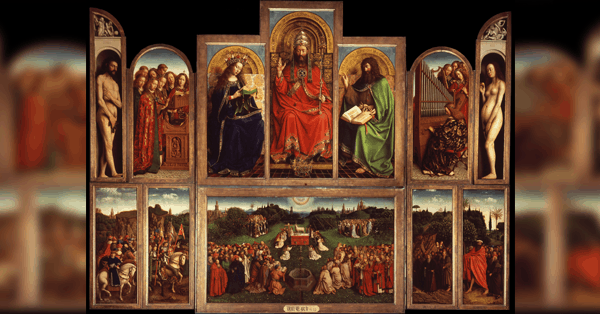
What is a “triptych” and “polyptych”? In this episode of 5 Minutes in Church History, Stephen Nichols takes us to the Ghent Altarpiece.
It was very common in medieval cathedrals to have what is called a triptych. A triptych is a trifold painting. It has three panels: a rather large panel in the center and two panels on the sides that fold in so that the triptych can be closed. And artists usually even painted the outside so that when it was folded in there would be a painting and then when it was opened up you would see the masterpiece.
In the cathedral at Ghent, Belgium, there is a polyptych called the Ghent Altarpiece. It is called a polyptych because it has far more than three panels. In has two levels to it, and in total it has twelve panels. It is an absolutely fascinating piece of art. It was begun by Hubert van Eyck and finished by his brother, Jan. So, we typically credit it to Jan van Eyck. It was installed in the cathedral on May 6, 1432.

This painting has a fascinating history. It was taken out of the Ghent Cathedral by none other than Napoleon, and then it was returned, only to be taken again during World War I by the Germans and again to be returned. And then it was taken in 1942 by the Nazis, and it spent three years buried in a salt mine. It actually made its way into the recent movie The Monuments Men, about the Allied soldiers tasked with finding art stolen by the Nazis, and it plays a significant role in that movie. The altarpiece suffered damage from its time in the salt mine because of the conditions there, and it was later restored. One of the panels was actually stolen in the 1930s, and when the painting was restored, the restorer, who was quite an artist himself, reproduced the missing panel.
At the very center of the top panel is a portrayal of God, and what’s fascinating about it is that to the left there is a pelican. The symbolism is important. The pelican was understood to eat its young on occasion, and so the idea is that God would sacrifice His very own Son. The panel beneath is the highlight of the piece; it is sometimes called The Adoration of the Lamb. It depicts Christ as a Lamb, lifted up above the altar and being sacrificed. The altar is surrounded by those who have gathered to worship and adore the Lamb. The upper panels on the far ends depict Adam and Eve, creation, and God at the center of creation, and then below, the panels illustrate redemption. So, we have the great work of God as Creator and the great work of God as our Redeemer in Jesus Christ.
This painting is one of the most famous paintings of Jan van Eyck. He is also known for other works of the pre-Renaissance period, but in the Ghent Altarpiece we see his finest work as he brings together these theological themes and presents for us a beautiful piece of art.
Stay connected with 5 Minutes in Church History by getting the weekly podcast on iTunes, SoundCloud, or via RSS. You can also subscribe to the blog via RSS and follow us on Twitter and Facebook.
(This podcast is by Ligonier Ministries. Discovered by e2 media network and our community — copyright is owned by the publisher, not e2 media network, and audio is streamed directly from their servers.)